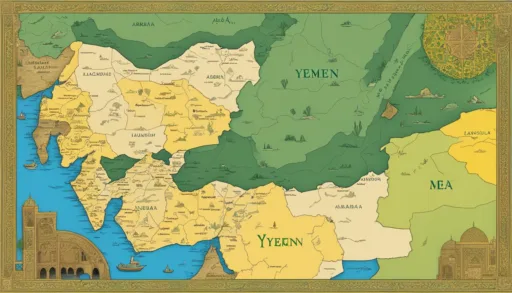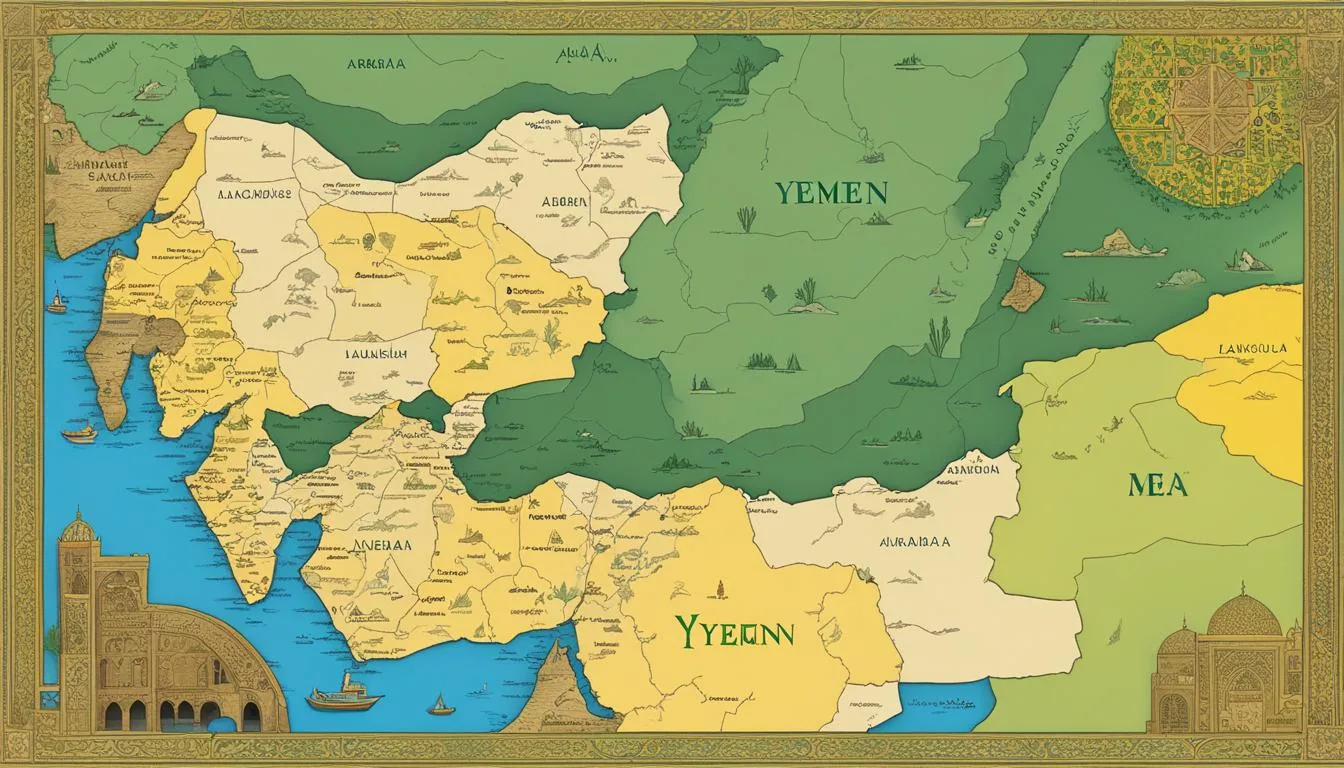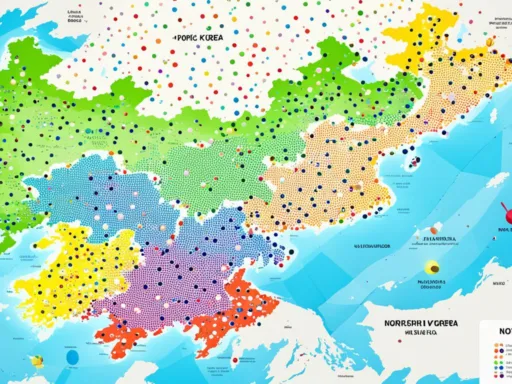In an era where global languages dominate communication channels, an unexpected fact stands out: Yemen, a country nestled on the Arabian Peninsula, is home to a symphony of languages, including a variety of Arabic dialects and several indigenous tongues. Not every day does one come across a nation with such an intricate linguistic fabric, yet Yemen boasts language diversity that is as staggering as its ancient history. Among the various languages spoken in Yemen, you’ll find that Arabic, in its Modern Standard form, is the official language, cementing itself in the realms of government, media, and education. Simultaneously, the country resonates with the vibrancy of its local dialects and minority languages that knit together the social and cultural identity of its people.
While Arabic might be the formal medium of communication, the dialects that embellish Yemen’s daily life are manifold, displaying the country’s profound Yemen language diversity. This myriad of dialects not only serves as a linguistic feature but is an essential thread in the fabric of Yemen’s cultural heritage. From the bustling markets of Sana’a to the remote mountainous regions where languages like Mehri and Soqotri are spoken, each lexicon adds a distinctive tone to the collective voice of this nation. What’s more, languages such as English and Russian also punctuate the official languages of Yemen, with their presence rooted in the country’s historical ties. It seems that in Yemen, every language tells a story, creating a narrative rich with ethnic and linguistic layers just waiting to be explored.
Key Takeaways
- Yemen’s linguistic tapestry includes various Arabic dialects and indigenous languages.
- Modern Standard Arabic is the official language used in Yemen’s governmental and educational spheres.
- Local Arabic dialects dominate everyday communication throughout diverse Yemeni communities.
- Indigenous languages such as Razihi and Soqotri are integral to preserving Yemen’s cultural heritage.
- Foreign languages like English and Russian add additional layers to Yemen’s linguistic diversity.
- Language in Yemen is a reflection of the country’s cultural complexity and ethnic richness.
Exploring Yemen’s Linguistic Landscape
The republic of Yemen, cradled at the southwestern tip of the Arabian Peninsula, is not just a crossroads of ancient trade routes but also a melting pot of linguistic variety. A closer look at the linguistic diversity Yemen presents reveals an intricate quilt of dialects and languages, each with its own historical significance and cultural nuance. The dialects in Yemen are not merely communicative tools but are deeply emblematic of the country’s social fabric and rich heritage.
Understanding Yemen’s Language Map
Yemen’s language map is dappled with a tapestry of dialects, where every thread contributes to the overall linguistic canvas. Sanaani Arabic, with its deeply rooted cultural and historical links, dominates the valleys of the central regions. Conversely, the southern skies are streaked with the vibrant shades of Ta’izzi-Adeni Arabic dialects, illustrating the profound regional character that language manifests. This linguistic landscape offers a fascinating glimpse into the lives of those who speak these tongues, each dialect painting a different facet of Yemeni life.
The Intersection of Language and Culture in Yemen
Language in Yemen is a kaleidoscope where every turn reveals a new pattern of cultural identity. Dialects in Yemen do more than facilitate communication; they act as the cornerstones of social identity and tribal lineage. Tribal affiliations resonate through the specific inflections and vocabulary inherent to regional dialects, with languages such as Razihi and Soqotri standing as living monuments to this diversity. These indigenous vernaculars are not only the voices of the present but also the echoes of Yemen’s ancestral roots, intimately shaping the cultural essence of the nation.
Fascination with Yemen’s linguistic diversity extends beyond mere academia; it also touches the hearts of those invested in the broader story of human culture. It’s within the bustling souks, the windswept mountains, and the arid plains that the story of Yemen’s languages—each an integral piece of the linguistic diversity Yemen is known for—is told and retold, generation after generation.
Yemen’s Official Language: Modern Standard Arabic
In the rich tapestry of Yemen’s linguistic heritage, Modern Standard Arabic holds a position of prestige and practicality. Established by the constitution in 1991, it serves as one of the official languages of Yemen, a beacon of unification in a nation celebrated for its cultural and linguistic diversity. Encompassing a wide spectrum of official domains, from governmental decrees to academic textbooks, Modern Standard Arabic is the cornerstone of formal communication in Yemen.
Approximately 17.7 million Yemenis are counted among the speakers of Modern Standard Arabic, a figure that reaffirms the language’s expansive reach and ingrained presence within the country’s populace. Yet, it’s noteworthy that while Modern Standard Arabic is the standardized form used in written media and formal education, it often relinquishes its conversational throne to the colloquial Yemeni Arabic dialects that animate day-to-day life.
In an effort to illustrate the significance of Modern Standard Arabic in Yemen, let us consider its role in different facets:
- Government: It functions as the primary mode of legal and administrative discourse.
- Education: As the medium of instruction, it bridges the linguistic gap among diverse communities.
- Media: Modern Standard Arabic allows for national and international news to be disseminated coherently.
This widespread utilization underscores the language’s vital function as a unifying element, binding the nation together beneath a common linguistic canopy. Yet, the vibrant interplay of the many Yemeni dialects continues to characterize the nation’s social fabric, preserving the intimate nuances of community and locale in the shadow of the official language. To navigate this linguistic landscape is to understand the pulse of Yemen itself—throbbing with tradition and echoing the heartbeat of its people.
The Varieties of Yemeni Arabic Dialects
Yemen, a country with deep historical roots and an array of rich cultures, is home to a fascinating variety of Arabic dialects. Among these major languages in Yemen, several stand out due to their distinctive phonological and linguistic features. The dialects of Yemen are as varied as the landscape, from the mountains of Sanaa to the southern coasts of Aden, each carrying the stories and identities of their speakers.
Comparing Sanaani, Ta’izzi-Adeni, and Hadrami Dialects
The dialectical diversity in Yemen is not only extensive but also particularly evocative of the country’s intricate social fabric. Here we explore the unique features of Sanaani Arabic, Ta’izzi-Adeni Arabic, and Hadrami language, which are among the most spoken dialects in Yemen.
| Dialect | Region | Number of Speakers | Notable Features |
|---|---|---|---|
| Sanaani Arabic | Central Yemen | 7.6 million | Stress on the last syllable; distinct intonation patterns |
| Ta’izzi-Adeni Arabic | Southern Yemen | 6.76 million | Inclusion of [ə] sound; use of definitive article ‘al’ as ‘a’ |
| Hadrami Language | Shabwah, Hadramawt governorates | 300,000 | Conservation of Classical Arabic features; slower speech tempo |
Uncovering the Characteristics of Gulf and Judeo-Yemeni Arabic
While dialects such as Sanaani Arabic, Ta’izzi-Adeni Arabic, and Hadrami language form the core of Yemen’s linguistic identity, there are other dialects that, although less widespread, carry an equal measure of historical and cultural significance. Gulf Arabic, spoken in coastal areas, showcases the cross-cultural trade influents, while Judeo-Yemeni Arabic, although its speakers are fewer, remains a poignant relic of Yemen’s once-thriving Jewish communities.
Each of these dialects provides us with a unique portal into understanding the multifarious identities within Yemen. They remind us that the country’s linguistic tapestry is as diverse and vibrant as the people themselves. As we delve deeper into understanding these dialects, we begin to appreciate the rich narratives they tell about Yemen’s storied past and complex present.
languages spoken Yemen: A Guide to Indigenous Tongues
Yemen’s cultural richness is vividly expressed through its native languages, which range from widely spoken tongues to those teetering on the brink of disappearance. The intricate web of indigenous dialects offers a glimpse into the diverse fabric of Yemen’s society, each language serving as a living repository of the nation’s history and traditions.
The Significance of Razihi, Soqotri, and Mehri Languages
Among the minority languages in Yemen, the Razihi language emerges as a bastion of linguistic resilience predominantly found in the Jabal Razih region. Marked by its distinct phonetic characteristics, Razihi holds significant cultural and social value to its speakers. Not far behind, the Soqotri and Mehri languages are vital to the islands and eastern parts of Yemen, acting as essential communicative tools that embody centuries of human interaction and stand witness to the nation’s age-old oral traditions.
The Mehri language, although lesser-known, plays a vital role in preserving the cultural identity of eastern Yemen’s indigenous people.
Potential Extinction of Bathari and Conservation of Hobyot
The Bathari language faces an imminent threat, with its speakers dwindling to critical levels. Its vulnerability underscores the urgent need for preservation actions to prevent its loss. Conversely, the Hobyot language demonstrates the power of community-driven conservation efforts. Despite being spoken by only a handful of individuals, it continues to resist linguistic homogenization, proving the determination of its speakers to sustain their mother tongue.
| Language | Region | Number of Speakers | Conservation Status |
|---|---|---|---|
| Razihi | Jabal Razih area | 70,000-80,000 | Vulnerable |
| Soqotri | Soqotra Archipelago | 70,000 | Stable |
| Mehri | Eastern Yemen | 115,000 | Endangered |
| Bathari | Al-Mahrah Governorate | Critically Endangered | |
| Hobyot | Al-Mahrah and Dhofar | Severely Endangered |
Documenting and revitalizing these tongues are not merely academic exercises; they are acts of cultural empowerment for the communities that speak them. The continued existence of Yemen’s minority languages is a barometer of the nation’s commitment to cherishing its heritage and ensuring that these linguistic jewels do not vanish amidst globalization’s sweeping currents.
Non-Arabic Languages Preserving Yemen’s Heritage
Linguistic diversity in Yemen extends beyond the ubiquity of Arabic dialects, revealing a mosaic of non-Arabic languages that contribute rich hues to the nation’s cultural fabric. Among them, Razihi, Soqotri, Mehri, Bathari, and Hobyot stand out as remarkable carriers of ancestral wisdom and communal identity. These languages are not merely tools for everyday communication; they encapsulate the voices of history and tradition within the remote enclaves where they are spoken.
In order to appreciate the importance of these non-Arabic languages in Yemen, it is essential to recognize their role in expressing and sustaining the intangible heritage of various Yemeni communities. Detailed in the table below are vital attributes of these languages that underscore their significance in the broader tapestry of Yemen’s linguistic diversity:
| Language | Region | Number of Speakers | Cultural Significance |
|---|---|---|---|
| Razihi | Jabal Razih | Est. tens of thousands | Embodies the heritage of the Razih mountain tribes. |
| Soqotri | Socotra Archipelago | Est. 70,000 | Represents a direct link to ancient Semitic languages. |
| Mehri | Al Mahrah, Hadramawt | Est. 165,000 | Unwritten language, rich in oral literature and poetry. |
| Bathari | Al Mahrah | Less than 100 | At risk of extinction, significant for language preservation efforts. |
| Hobyot | Oman-Yemen border | Est. less than 100 | A linguistic relic, symbolizing cross-border cultural continuity. |
Yemen’s commitment to linguistic preservation can play a pivotal role in ensuring these languages do not succumb to the shadows of oblivion, but rather continue to showcase the rich tapestry of linguistic diversity Yemen boasts. It becomes a collective responsibility to safeguard these treasures of non-Arabic languages that uphold Yemen’s multifaceted heritage for future generations.
Foreign Languages Influencing Yemen’s Society
In Yemen, a country traditionally rich in Arabic dialects, the role of foreign languages has become increasingly significant, especially with regard to English and Russian. These languages have woven themselves into the fabric of Yemeni society, impacting areas such as education, international relations, and commerce.
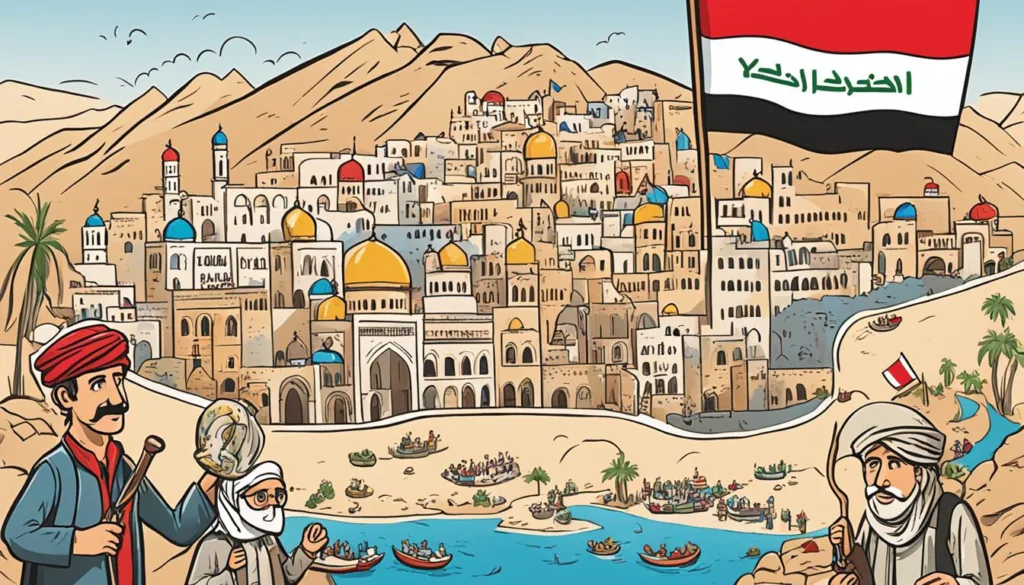
The Role of English in Yemen’s Global Communication
The English language in Yemen has cemented its position as a lingua franca in the realms of business and higher education. Predominantly influenced by the British during the colonial era, English has provided Yemen with an essential tool for global communication and international commerce.
Russian Language Presence and Its Historical Context
The Russian language in Yemen, though less widespread, offers a historical narrative rich with bi-cultural exchange that dates back several decades. Russian expatriates and their families have contributed to creating a distinctive societal enclave, adding texture to Yemen’s linguistic and cultural landscape.
The Role of Language in Yemeni Media
The fabric of Yemen’s media landscape is woven predominantly with threads of Arabic language, influencing not just entertainment but also shaping political discourse and public opinion. Amidst ongoing conflict, media language in Arabic becomes a stronghold and a voice for competing narratives, with each faction leveraging it to broadcast its ideology to the wider population.
In light of recent upheavals, the Yemeni press has been caught in an ideological tug-of-war, where language is more than a tool of communication—it’s a symbol of allegiance and defiance. Particularly, Arabic media has become a pivotal battleground for Houthi-controlled regions and government-loyal territories, manifesting the power of languages spoken in Yemen as instruments for ideological and political representations.
Despite the strain on press freedom and the varying control over media outlets, official Arabic language media continues to find resonance among the general population, emphasizing the critical place language holds in the hearts and minds of Yemeni people.
Here’s a quick look at the prevailing state of the Yemeni media:
| Platform | Language Dominance | Impact on Public Opinion |
|---|---|---|
| Television | Arabic | High |
| Radio | Arabic | Medium |
| Print Media | Arabic | Low (Dwindling) |
| Online Media | Mixed (Arabic and English) | Growing |
Conclusively, the essence of media in shaping modern society is undeniable, and in Yemen, Arabic serves as the key to unlocking the vast majority of content consumed by its citizens. Understanding the dynamics of media language Arabic is essential for anyone looking to grasp the cultural and political complexities within this nation.
Language Use in Yemen’s Educational System
Central to the educational landscape of Yemen is the predominant use of Modern Standard Arabic. This language not only facilitates academic exchanges but also ensures that the complexity of languages spoken in Yemen are woven into a unified educational fabric. The infusion of Modern Standard Arabic within classrooms across the country elevates it to more than merely a means of communication; it becomes a bridge connecting diverse linguistic communities.
At the heart of language education in Yemen lies the goal of national literacy, accessible to all students. By integrating a standardized form of Arabic as a medium of instruction, Yemen’s education system transcends regional dialectical variations, promoting inclusivity and equal opportunities for learning.
| Education Level | Language of Instruction | Second Languages Offered |
|---|---|---|
| Primary | Modern Standard Arabic | English (begins in late primary) |
| Secondary | Modern Standard Arabic | English |
| Higher Education | Modern Standard Arabic | English, and other foreign languages |
| Adult Education | Modern Standard Arabic | Vocational language options |
Within this system, English has been introduced as a significant secondary language, typically starting during the latter years of primary education. It represents the global perspective that Yemen aspires to instill in its students, while not compromising on the integrity of its national language standards.
Despite the robust implementation of a standardized language education, dialects continue to be a part of Yemen’s rich cultural identity, often serving as a link to one’s heritage and community. The educational system of Yemen, while firm in its approach, subtly acknowledges the value of dialectal diversity outside the academic sphere.
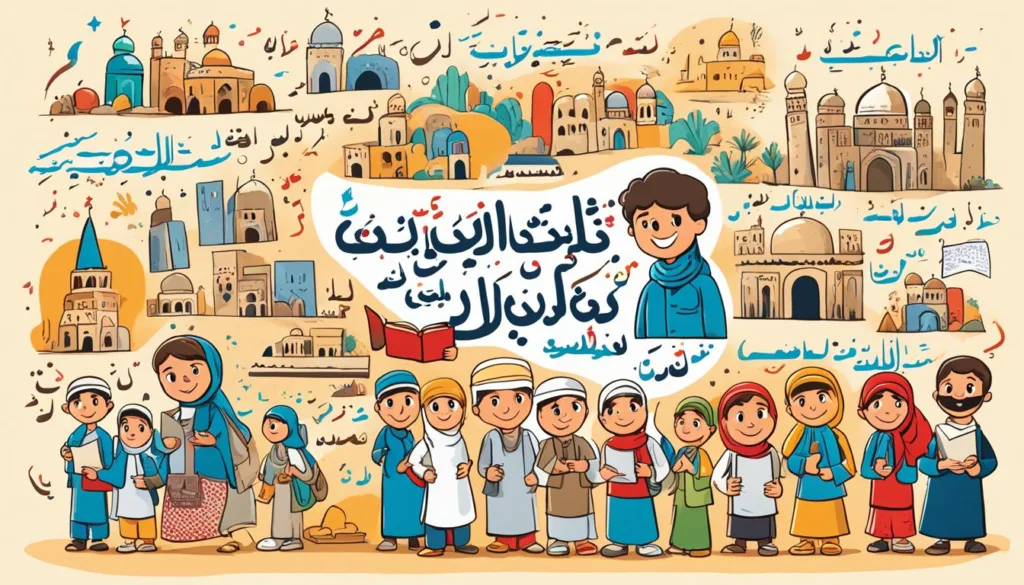
As Yemen confronts the challenges of the 21st century, it navigates with a firm grasp on language as both a pedagogic tool and a cultural cornerstone. The harmonization of Modern Standard Arabic with local dialects and global languages in Yemen’s schools sets forth a model of linguistic unity amidst diversity.
Linguistic Diversity Yemen: Identity and Unity
The linguistic variety within Yemen’s borders paints a vivid image of its socio-ethnic tapestry, with each language and dialect contributing to the cultural complexity of the nation. Yemen language diversity is not merely a collection of communication systems but a profound reflection of the country’s tribal and social nuances. These communicative practices are windows into the realm of Yemen’s multifaceted traditions and ways of life, harboring stories of historical significance and societal structure.
How Language Diversity Reflects Yemen’s Socio-ethnic Fabric
Language in Yemen does more than facilitate conversation; it embodies the identity of its people. The indigenous languages such as Mehri and Soqotri and the spread of various Arabic dialects signal the deeply ingrained tribal allegiances that are central to Yemeni life. These languages serve as indicators of regional heritage, each upholding unique linguistic characteristics bred through time and place. As such, linguistic diversity in Yemen acts as a repository of cultural identity, narrating the complex web of society’s fabric.
Language as a Unifying Factor Amidst Diversity
While diversity in language might suggest division, in Yemen, it is a symbol of unity and strength. The ubiquitous presence of Arabic, with its multiple dialects, is a force that binds Yemenis together. It transcends local variations, ensuring cohesion and facilitating understanding amongst Yemen’s communities. This shared linguistic thread exemplifies the unity of the nation, fostering solidarity while allowing the celebration of regional and tribal idiosyncrasies.
| Language | Region | Number of speakers | Notes |
|---|---|---|---|
| Modern Standard Arabic | Nationwide | Approx. 30 million | Official language used in government and media |
| Sanaani Arabic | Central regions | 7.6 million | Distinctive to the Sana’a area |
| Ta’izzi-Adeni Arabic | Southern regions | 6.76 million | Common in areas such as Ta’izz and Aden |
| Razihi | Jabal Razih area | Limited community | Non-Arabic language facing decline |
| Soqotri | Socotra archipelago | 70,000 | Indigenous language with distinct roots |
Challenges Faced by Minority Languages in Yemen
The cultural and linguistic landscape of Yemen is beautifully complex. However, the minority languages within the country are currently experiencing significant challenges that threaten their continued existence. Despite Yemen’s rich cultural heritage, the erosion of linguistic diversity is a pressing issue. Factors such as rapidly declining numbers of native speakers, the impact of globalization, and lack of institutional support profoundly affect language preservation in Yemen.

Among these languages, Bathari stands on the brink of extinction, signaling a critical need for immediate conservation efforts. Nevertheless, community resilience shines through as local and international linguists join forces in a quest to document and revitalize these enduring symbols of Yemen’s identity. The table below encapsulates the core difficulties facing these minority languages and the efforts in place to mitigate them.
| Minority Language | Number of Native Speakers | Challenges | Conservation Measures |
|---|---|---|---|
| Bathari | Less than 50 | Risk of extinction | Documentation and academic study |
| Mehri | Approximately 70,000 | Limited intergenerational transmission | Recording of oral traditions |
| Soqotri | Estimated 70,000 | Globalization pressure | Community-led language courses |
| Hobyot | Less than 100 | Socioeconomic language displacement | Cultural festivals and language workshops |
The plight of minority languages in Yemen serves as a call to action for proactive language preservation strategies. By raising awareness of these issues and rallying support from both local communities and the international arena, there is hope for these languages to withstand the test of time and continue their story of cultural resilience.
Cultural Implications of Language Evolution in Yemen
Yemen’s linguistic journey is deeply interwoven with its cultural dynamics, reflecting centuries of social transformations, migrations, and the shifting sands of geopolitics. This intricate path of language diversification and evolution holds profound implications for Yemen’s cultural identity and bears witness to a history both rich and turbulent.
Tracking Changes and Influences Over Time
The layers of language diversity Yemen has experienced stem from the country’s position as a historic nexus of trade routes and cultures. Interactions with African, Asian, and European merchants and conquerors have each left an indelible mark on the country’s spoken words. The imprints of these linguistic influences are found not only in the local dialects but also in the collective memory of the Yemeni people, shaping their worldviews and social practices.
Future of Yemeni Languages in a Globalizing World
As globalization forges ahead, the endurance of Yemen’s language heritage faces novel challenges. The global exchange of ideas and technology presents a paradox—while it can lead to increased homogeneity, it also has the potential to raise awareness of the need to preserve cultural diversity. In the realm of language evolution Yemen, a balance must be achieved between embracing beneficial global shifts and safeguarding the linguistic landmarks of Yemen’s heritage.
Conclusion
As we’ve journeyed through the linguistic landscape of Yemen, we’ve encountered a vibrant mosaic of languages spoken in Yemen, each a thread in the nation’s rich cultural fabric. From the widespread use of various Arabic dialects to the more secluded indigenous and minority languages, Yemen presents an exceptional case study of language diversity and resilience. These tongues are not mere means of communication; they are emblems of Yemen’s deep ethnic roots and a historical canvas etched with stories of its people.
The linguistic future of Yemen is set against the backdrop of a world where global interaction is intensifying. With the responsibility to preserve its linguistic heritage, Yemen is poised on a tightrope, balancing the conservation of its ancestral languages with the need to embrace global languages for wider communication and development. This challenge summons a call to action for linguistic scholars, community leaders, and policy-makers to ensure that Yemen’s treasured languages thrive amidst the forces of modernization.
In the echoing voices of today’s Yemeni people lies the indomitable spirit of their forebearers, continuing the legacy of their distinctive dialects and honoring the memory of tongues at the brink of silence. Charting the course for a future rich with linguistic diversity requires collective effort and recognition of each language’s intrinsic value. The ongoing narrative of Yemen’s languages is a testament to human adaptability and cultural pride, promising a horizon where every word spoken is a bridge between generations and a celebration of identity.
